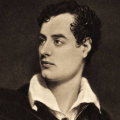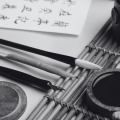Metre, both in free verse and traditional, structured poetry, is extremely important. It gives poetry its pace and can often contribute to its overall structure.
Understanding metre can help with both reading and writing poetry. Even iambic pentameter, the most common metre used in English language poetry, can help you to elevate prose into poetry.
Of course, if you’re predominantly a free verse poet, like myself, it can be easy to look over examples of metre as archaic. However, an understanding of metre, and how they can be used within your poem, or even carefully avoided, can really help to improve.
Even if you don’t write metered poetry, understanding it can really make a difference in your own writing, and your appreciation of other poets’ work.
Contents
What Is Metre in Poetry?
Metre, in poetry, is often the defining characteristic which distinguishes poetry from prose. Almost every poetic line used in structured poetry such as sonnets, ballads, villanelles, blank verse and other forms relies on a combination of syllables which are either stressed or unstressed to create a metrical pattern.
This metrical pattern is what gives the poetry its rhythm, which makes structured poetry significantly more musical than other forms of writing.
Is It Meter or Metre In Poetry?
First of all, both are acceptable in my opinion. I believe that metre and meter can be used interchangeably, whether you’re English, American or whatever. The important thing, when it comes to poetic meter is your understanding of metrical feet, and how best to read or use meter in poetry.
What Is The Difference Between Rhyme And Metre?
The main difference between rhyme and metre in poetry is that rhyme is a repetition of similar-sounding words at the end of lines while metre is a stressed and unstressed pattern of syllables.
What Is A Poetic Metre Example?
You could look at almost any traditional poem for an example of poetic metre. However, some of the most famous examples is probably ‘The Waste Land’ by T.S. Eliot, which uses a mix of iambic pentameter and dactylic hexameter, or Paradise Lost, by John Milton.
In terms of looking for an easy example of iambic pentameter as a poetic metre, I prefer to look at a slightly older poet – William Wordsworth. One of his most famous poems, “Tintern Abbey” is a clear example of iambic pentameter.
Each line has the same number of syllables, ten, with one out of every two syllables being stressed. This is carried throughout the entire poem, but to keep the example simple, I have simply chosen the first couplet.
“Five years have passed; five summers, with the length
Of five long winters! and again I hear“
Each bolded syllable above is a stressed syllable. As you can see, the stress patterns remain consistent across both lines. This basic rhythmic structure is the core of English blank verse and remains one of the most common poetic forms in English language poetry.
How Do You Define Metre in Poetry?
A metre, in poetry, is essentially the pattern of stressed and unstressed syllables in a line of verse. The study of metre is known as prosody, and poets use it to create musical effects in their writing.
There are many different types of metre, but the most common are iambic, trochaic, anapaestic, dactylic, pentameter and hexameter. Iambic metre, for example, is created by using an iamb (an unstressed syllable followed by a stressed syllable) as the basic unit of measurement.
How Does Metre Affect The Meaning Of A Poem?
The metrical form of a poem can often have a significant impact on its meaning. For example, a light, playful poem is likely to be less serious in tone if it is written in dactylic hexameter (a metre often used in epic poetry) than if it were written in iambic pentameter (a metre often used in love poetry). Similarly, a dark, brooding poem is likely to be more sinister if it is written in iambic pentameter than if it were written in dactylic hexameter. The metrical form of a poem can therefore give the reader clues as to its overall tone and mood.
What Are Poetic Elements?
There are many different elements that can be found in poetry, but some of the most common are metre, rhyme, stanza, alliteration and simile.
Metre is the rhythm of a poem, created by the patterns of stressed and unstressed syllables.
Rhyme is the repetition of sounds, usually at the end of lines.
A stanza is a group of lines, usually of the same length, which are connected to each other in some way.
Alliteration is the repetition of sounds at the beginning of words. Examples of this include plosive, which are repeated Ps and Bs.
A simile is a figure of speech that compares two things using the words “like” or “as”.
How Can You Tell The Metre Of A Poem?
The easiest way of identifying the metre of a poem is to read it out loud and listen to the natural cadence, or rhythm, of the words. This will help you to work out which syllables are stressed, and which are unstressed. You can then compare this pattern to known poetic metre examples to see if the poem matches up. You can also, if you know the different metres commonly used in structured poetry, count the syllables on your fingers, and see where the stressed and unstressed syllables fall.
When writing in metre, traditional poets often use a regular pattern of stressed and unstressed syllables to create a steady beat.
How To Identify Stressed and Unstressed Syllables?
Identifying both stressed and unstressed syllables is one of the great challenges of structured poetry. When writing in a traditional poetic meter, you often need to change or adapt what you want to say to fit the form of a poem, whether that relates to its rhyming structure, or iambic meter.
It’s one of the reasons why blank verse, or unrhymed iambic pentameter, became so incredibly popular in English language poetry. It’s hard enough writing in a poetic form, such as iambic tetrameter,
How Do You Analyse Metre In A Poem?
The first step is to read the poem aloud several times to get a feel for its natural rhythm. Once you have done this, you can start to break the poem down into its component parts.
To do this, you will need to mark where each foot begins and ends. You can do this by underlining each foot, or by using a system of symbols (such as “/” for an iamb, “-” for a spondee, “u” for a trochee, and so on).
Once you have done this, you can begin to analyse the metre of the poem. This will involve looking at the types of feet used, the length of each line, and the overall pattern of the poem.
You should also pay attention to any variations in the metre, such as changes in tempo or meter, which can be used for emphasis or to create a particular effect.
What Are The Five Basic Metrical Feet Used in English Poetry?
The five basic types of metrical feet which are used in English poetry include:
- Iamb – An iamb is an example of alternating unstressed and stressed syllables. Interestingly, an Iamb comes from the Latin for goat. Initially, an Iambic poetic metre was said to represent the sound of a goat walking.
- Trochee – A trochee is an example of a metrical foot that has a stressed syllable followed by an unstressed syllable.
- Spondee – A spondee is an example of a metrical foot that has two stressed syllables.
- Anapaest – An anapaest is an example of a metrical foot that has two unstressed syllables followed by a stressed syllable.
- Dactyl – A dactyl is an example of a metrical foot that has a stressed syllable followed by two unstressed syllables.
These types of metre can be used in a wide range of forms, including diameter, tetrameter, pentameter and so on.
What Is Iambic Pentameter?
Iambic pentameter is the most common form of metre in English poetry, and if commonly found in Blank verse poems and traditional dramatic writing, such as the works of William Shakespeare. It is also often used in song lyrics, as the regular beat of the metre can add a pleasing rhythm when sung or read aloud.
The word ‘iamb’ comes from the Greek term for ‘substitute’, as an iamb is a short, unstressed syllable followed by a long or stressed syllable. In iambic pentameter, there are five iambs (two syllables) per line, hence the name ‘pentameter’. This gives the metre a characteristically lilting quality which can be quite musical.
What Is Anapaestic Tetrameter?
Anapaestic Tetrameter is a foot in poetry. It is made up of four anapaests, which are two unstressed syllables followed by a stressed syllable. This type of meter is often used in light verse and comic poetry because of its traditionally bouncy rhythm.
What Is Dactylic Hexameter?
Dactylic Hexameter is a poetic meter that consists of six dactyls per line. A dactyl is a metrical foot consisting of one stressed syllable followed by two unstressed syllables.
What Is Iambic Trimeter?
Iambic Trimeter is a meter in poetry consisting of three iambs per line. An iamb is a metrical foot consisting of an unstressed syllable followed by a stressed syllable. This type of meter gives poems a very musical quality, which is why it is often used in song lyrics.
What Is A Spondee?
A spondee is a metrical foot consisting of two stressed syllables. This type of foot is not often used in English poetry, but it can be found in some works, such as those by the Anglo-Saxon poet Beowulf.
What Is Qualitative And Quantitative Meter?
Quantitative verse is based on the length of the stressed syllables, while qualitative verse is based on the number of syllables. In English, quantitative meter is very rare, and most metrical poetry is qualitative.
One of the most famous examples of quantitative meter in English is found in Paradise Lost by John Milton. In this poem, each line has 10 syllables, but the stresses fall on different syllables depending on the quantity of the vowel sound.
A qualitative meter, such as iambic pentameter, is based on the number of syllables in a line, rather than stress. In this type of meter, each line contains 10 syllables, with the stresses falling on every second syllable.
It can be difficult and often clumsy to write quantitative verse, based on syllable length, so it’s no surprise qualitative verse is the most predominant form of structure poetry.
Why Is Poetic Form Important?
Poetic form is important in that it gives structure to a poem and helps elevate the poetic work from prose to poetry. In the past, there has also been associations between poems written in the same form. Sonnets, for example, come with an expectation of the poem being about love, or some form of affection. As such, anyone reading a sonnet will naturally go looking for these themes as a focal point.
Poetic form is, essentially, a powerful literary device, allowing the poet to not only create a sense of pace and structure within their work, but also to position it within the great poetic works of the past.
I hope you’ve found this article useful! In poetry, meter (or metre, let’s not have that argument again) is an extremely powerful tool, whether you’re writing in trochaic tetrameter, dactyl meter or an iamb meter.
For more information on any poetic metrical terms, don’t hesitate to get in touch! I’m more than happy to talk through anything poetic, whether you’re looking to carry out metrical analysis, write poetry in common meter, or you want to experiment with some of the more esoteric forms of poetic meter out there.
- Glossary of Japanese Poetry Terms - 26 February 2025
- What is Waka Poetry? - 23 May 2024
- How to Identify the Kigo in a Haiku: - 22 March 2024





